Tong W. Wind Power Generation and Wind Turbine Design
Подождите немного. Документ загружается.

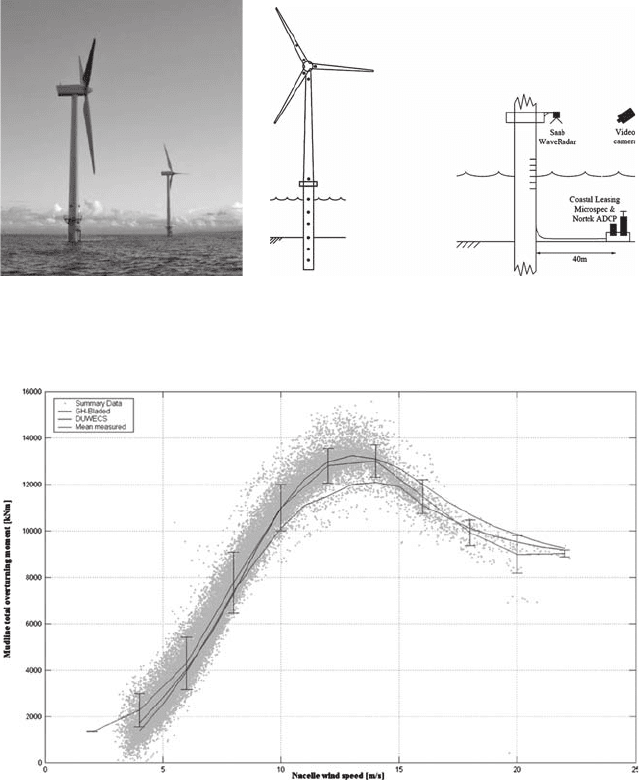
Design of Support Structures for Offshore Wind Turbines 565
One of the turbines is fi tted with a complete measurement system to record external
conditions and structural response. A picture of the turbines and the measurement
systems is shown in Fig. 9 .
The measurements were used to validate the current design tools for offshore wind
turbines. It was found that present-day tools are very able to model the offshore wind
turbine behaviour induced by wind and waves simulations. Figure 10 shows the
comparison of measured and modelled mudline bending moment per wind speed.
It was found that offshore wind turbine design is very dependent on site-specifi c
features like the wind and wave climate. At Blyth the local bathymetry is such that
Outboard (one blade)
Blade Root (all blades)
Mean Sea Level
Depth 1
Depth 2
Sea Bed
Foundation Depth 1
Foundation Depth 2
Tower Base
Tower Height 1
Figure 9 : Turbines at Blyth with complete measurement system for external loads
and responses.
Figure 10 : Comparison of mudline bending moment form measurements and
modelling.
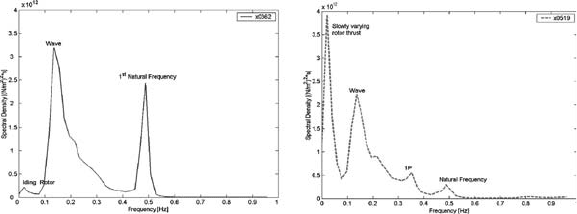
566 Wind Power Generation and Wind Turbine Design
near the turbines breaking waves are a common phenomenon. Although their infl u-
ence did not affect the design dramatically in this particular case, they prove the
importance of taking all details of a site into account.
Although the natural frequency of the structure is rather high at 0.48 Hz, the
effect of both wind and wave loading on resonance is signifi cant, as is the aerody-
namic damping. Figure 11 shows the response spectrum for the mudline bending
stress for equal environmental condition with an idling rotor (left) and a turbine in
operation (right). The signifi cant resonance peak in the wave-only case is damped
dramatically when the turbine is operating.
From the measurements at Blyth it can be concluded that current modelling
techniques are able to represent the critical features of offshore wind turbines
properly, especially when on hindsight all structural and environmental param-
eters are known. It has also been shown that monopile structures are very dynam-
ically sensitive, even in this case with relatively high natural frequency and that
therefore proper analysis of resonant behaviour and aerodynamic damping
deserve special attention.
3 S upport structure concepts
3.1 Basic functions
The basic function of the support structure is to keep the wind turbine in place. This
means that it has to be built to withstand loads originating from sea currents, waves
and wind – acting on both the support structure and the turbine in operation.
A variety of wind turbines is available on the market, designed by different
turbine manufacturers, in a range of power ratings. Each wind turbine has different
characteristics. The offshore environmental conditions may also vary from site to
site. Therefore, support structures are designed specifi cally for each case. It is not
uncommon for one offshore site to have several variations of one type of support
structure for one type of turbine.
The cost of the support structure on average amounts to around 25% of the total
offshore wind turbine cost [ 1 ].
Figure 11: Response spectrum for mudline bending stress for idling (left) and
operating (right) turbine.
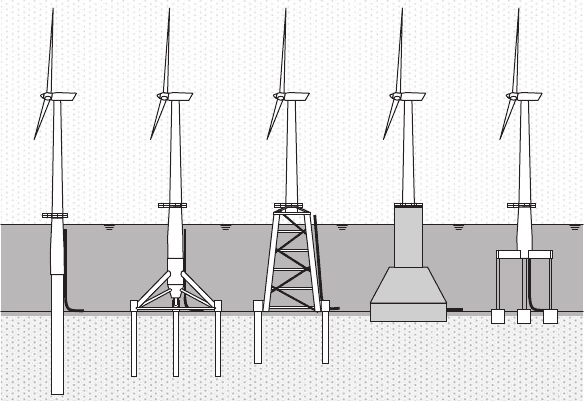
Design of Support Structures for Offshore Wind Turbines 567
Typically the support structure is divided in two main parts:
The turbine tower 1.
The foundation 2.
The turbine tower normally consists of two or three sections. The design of the
tower is usually provided by the turbine manufacturer. The tower is often installed
in the same shift as the nacelle and the rotor.
The term foundation here refers to the turbine support structure, excluding the
tower. It is essentially located below and at the water level. The function of the
foundation is to direct the loads on the support structure into the seabed.
Many types of foundation for offshore wind turbines already exist. Essentially,
the manner in which they are connected to the seabed determines how they are
classifi ed. The choice of foundation type depends primarily on the local water
depth at the proposed site.
3.2 Foundation types
3.2.1 Monopile
The most frequently used foundation type is the monopile. It commonly consists
of a foundation pile and a transition piece, on top of which the turbine tower is
placed, as shown in Fig. 12 .
Foundation piles are made from steel plates which are rolled and welded together
to form a cylindrical section. The conventional method of installation (see Fig. 13 )
Figure 12: Foundation types, from left to right: monopole, tripod, jacket, GBS,
fl oating.
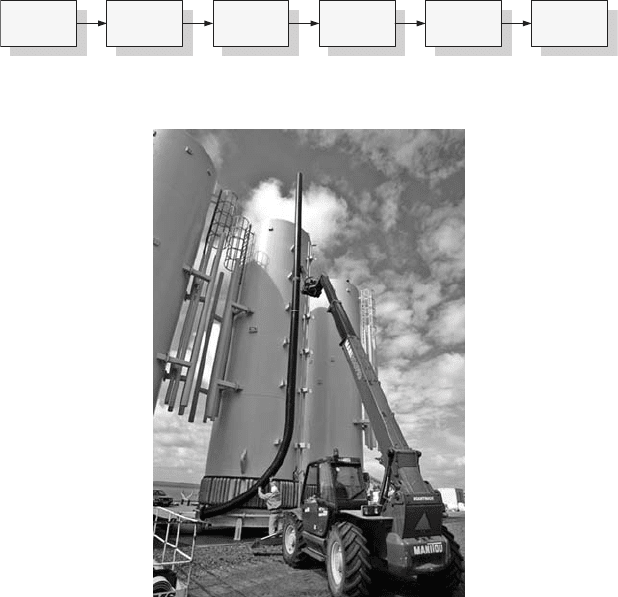
568 Wind Power Generation and Wind Turbine Design
is by pile driving, whereby the foundation pile is driven into the seabed using
hydraulic hammers.
If a foundation pile is designed to be driven into the seabed, a transition piece is
required for the secondary structures such as J-tubes, boat landings and platforms
as shown in Fig. 14 .
If the seabed consists of rock, a borehole is prepared (drilled) in which the foun-
dation pile is inserted. Since the foundation does not have to be designed for the
impact forces of pile driving, the secondary structures can be attached directly to
the foundation pile. Hence, no transition piece is needed.
Water currents fl owing around the pile can, through erosion, create a depres-
sion in the seabed around the base of the pile, known as scour. The effect of scour
on the foundation pile is as if it is positioned in deeper water with reduced soil-
penetration depth. The depth of a scour hole depends on local currents and soil
conditions, which is why it cannot be predicted accurately. Furthermore, an
increased section of the pile is exposed to hydrodynamic loads. The increased
length of the unsupported structure above the seabed may also result in a more
dynamic behaviour.
Figure 14: The J-tube through which the power cable is directed to the seabed.
Foundation
pile
Scour
protection
Transition
piece
Turbine
Tower
Nacelle Rotor blades
Figure 13 : Installation sequence of main components for a monopile foundation.
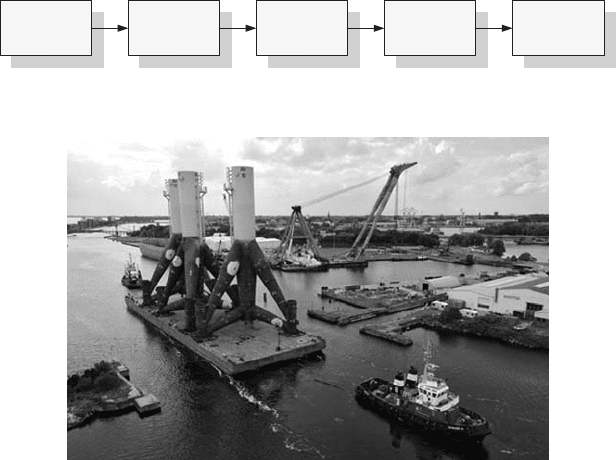
Design of Support Structures for Offshore Wind Turbines 569
To avoid scour, monopiles are provided with scour protection . Protection against
scour is usually done by placing a “fi lter” layer of small stones around the pile. On
top of that a layer of larger stones is positioned. The small stones keep the sand
around the pile in place and the large stones keep the fi lter layer in place.
The relatively simple production and installation, together with the large range
of exploitable water depths, have made the monopile the most widely used support
structure concept. Its popularity has led the monopile to be developed for increas-
ingly deeper waters. Monopiles are therefore likely to remain the most popular
foundation type in the near future.
3.2.2 Tripod
A tripod foundation is a structure with three legs which diverge from a single node
to their respective positions on the seabed. A foundation pile is driven into the
ground at the base of each leg of the tripod section. On top of the tripod section,
the turbine tower is placed. The procedure is visualised in Fig. 15 .
Complications with production and installation make it relatively expensive.
The main transition node where the three legs meet the central column is sensitive
to fatigue. Stiffness benefi ts are only interesting in large water depths, but then the
base becomes restrictively large.
The conventional installation method is to load several tripods onto a barge
which is towed to the offshore site as depicted in Fig. 16 . At a predetermined loca-
tion, a structure is lifted of the barge, using a large crane (on the barge). Simultane-
ously, a smaller crane guides the tripod to its fi nal position. The loads on the tripod
Foundation piles
Lifting and
landing of tripod
Turbine Tower Nacelle Rotor blades
Figure 15: Installation sequence of main components for a tripod foundation.
Figure 16 : Tripods on a barge, on their way to the Alpha Ventus wind farm.
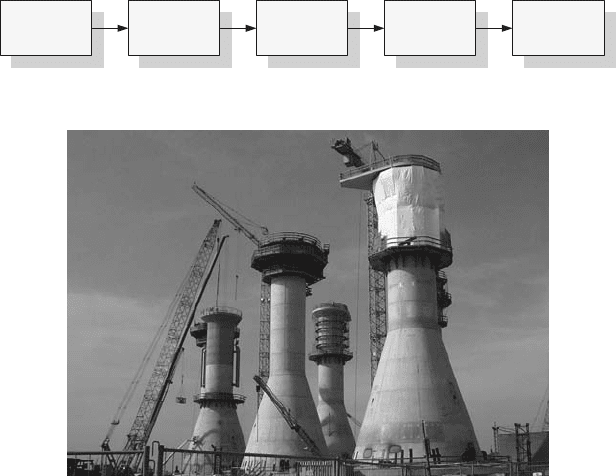
570 Wind Power Generation and Wind Turbine Design
structure will be mainly in axial direction. Therefore, scour protection is generally
not required.
3.2.3 Jacket
Jackets, also known as space-frames or truss-towers, are relatively complex steel
structures. Despite a reduction in construction materials (and hence weight), jack-
ets are relatively expensive.
At the water depth where monopiles become uneconomical, jackets take over.
However, due to ongoing developments, the monopile concept is used for increas-
ingly deeper waters and the application of jackets is shifted to even deeper waters.
For installation, a method similar to the one for tripods is applied (see Fig. 17 ).
3.2.4 Gravity-based structures
As the name implies, a gravity-based structure (GBS) utilizes the earth’s gravita-
tional force to stabilize its position.
GBSs usually have reinforced concrete foundations, referred to as caissons, in
which a tower is placed. An example of GBSs for offshore wind turbines is
shown in Fig. 18 . Such GBSs are a proven technology for shallow waters. Occa-
sionally they are used in deeper waters. The offshore wind farm Thornton Bank
off the coast of Belgium applied reinforced concrete GBSs for a water depth of
approximately 28 m.
Deeper waters require constructions with larger footprints in order to absorb
greater moments. The increase of mass with water depth follows an approximately
Foundation piles
Lifting and
landing of jacket
Turbine Tower Nacelle Rotor blades
Figure 17: Installation sequence of main components for a jacket foundation.
Figure 18 : GBSs for Thornton Bank, off the coast of Belgium.
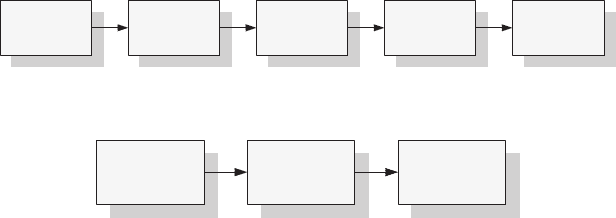
Design of Support Structures for Offshore Wind Turbines 571
quadratic relation. So even though building with concrete appears an economic
choice, the large amounts required will make the structure relatively expensive.
An advantage with respect to installation is that a GBS can be fl oated out to its
offshore location. A disadvantage is the necessary preparation of the seabed, which
is done to provide the structure with a stable, horizontal fl oor. Another drawback is
that, due to the great weight of the GBS, heavy lifting vessels are needed to perform
the installation. The conventional installation sequence is shown in Fig. 19 .
3.2.5 Floaters
The maximum water depth of wind farms has been steadily increasing over the last
decade. Although monopiles will likely continue to be the most applied support
structure for years to come, deeper waters appear to favour jacket structures.
Floating structures are seen by many as the solution to place wind farms in
deeper waters (>70 μ ). To keep it in place, the fl oating substructure is attached to
the seabed through cables. In terms of installation costs, the question is whether
such a system will require new installation procedures and dedicated vessels, or if
it can simply be pre-assembled and transported by standard tugs (see Fig. 20 ).
4 E nvironmental loads
4.1 Waves
When calculating wave loads different wave categories can be distinguished, regular
waves and irregular waves. Regular waves are periodic in nature and are usually asso-
ciated with extreme load events. Irregular waves have a random appearance and are
related to normal sea conditions and as such are to be adopted for fatigue evaluations.
For both regular and irregular waves several wave theories exist that allow the
calculation of wave particle kinematics: the orbital motion, velocity and accelera-
tion of infi nitesimal quantities of water beneath the surface of the waves. Linear
wave theory is valid for waves with infi nitely small amplitudes, whereas non-linear
wave theories are required for fi nite amplitude waves. Non-linear waves have a
different surface profi le compared to linear waves, with sharper, higher crests and
longer and shallower troughs. Figure 21 shows which wave theory applies under
Seabed
preparation
Lifting and
landing of GBS
Turbine Tower Nacelle Rotor blades
Figure 19: Installation sequence of main components for a GBS foundation.
Assemble
completely in
harbor
Tug to location
Attach cables to
seabed
Figure 20 : Proposed installation sequence for fl oating turbines.
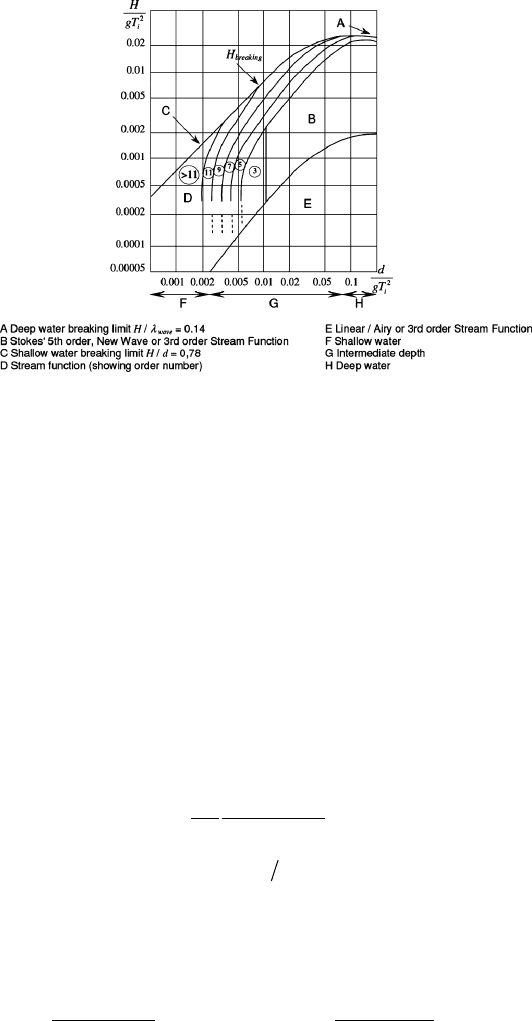
572 Wind Power Generation and Wind Turbine Design
certain depth and wave steepness conditions. It can be seen that linear Airy wave
theory can be applied in deep water waves with small steepness. Beyond this
region non-linear wave theories such as Stokes’ 5th order and stream function
waves apply. This region in turn is limited by the wave breaking limit. In shallow
water waves cannot grow higher than 0.78 times the water depth, while in deep
water a wave will break if it grows too steep, with the wave height exceeding
0.14 times the wave length.
Linear Airy wave theory considers the surface elevation to be described by a
harmonic wave:
(,) sin( )xt a t kxhw=−
( 1)
Using potential theory and boundary conditions at the seabed and at the free
surface a velocity potential F can be formulated corresponding to the surface ele-
vation described as in the following equation:
cosh ( )
(,,) cos( )
sinh
akhz
xzt t kx
kkh
w
w
+
Φ= −
(2 )
In this equation the term
cosh ( ) sinhkh z kh+ is the exponential decay func-
tion that describes the decrease of the intensity of the kinematics with increas-
ing depth. By differentiating the velocity potential with respect to x and z the
horizontal velocity u and the vertical velocity w can be derived, respectively,
as follows:
cosh ( ) sinh ( )
sin( ), cos( )
sinh sinh
kh z kh z
ua tkxwa tkx
kh kh
wwww
++
=−=−
( 3 )
The accelerations can be determined by differentiation of the horizontal and
vertical velocities with respect to t .
Figure 21: Range of application of various wave theories.

Design of Support Structures for Offshore Wind Turbines 573
22
cosh ( ) sinh ( )
cos( ), sin( )
sinh sinh
kh z kh z
ua tkxwa tkx
kh kh
wwww
++
=−=−
(4 )
As the above formulations are based on linear wave theory, assuming small
amplitude waves, the kinematics can only be calculated up to the still water sur-
face. To allow for the calculation of the kinematics up to the instantaneous water
surface elevation some kind of extrapolation is required. Several methods exist
of which Wheeler stretching is the most common. Up till now the origin was
assumed to be in the still water line, with the negative x -axis directed downward.
By applying Wheeler stretching, the negative x -axis is stretched or compressed
such that the origin is in the instantaneous water surface, yet intersects the sea-
bed at the same z coordinate as the original z -axis. To this end a computational
vertical coordinate z ′ is used that modifi es the original coordinate z with the use
of the dimensionless ratio q , which is dependent on the water depth h and the
surface elevation z . Using Wheeler stretching therefore implies that the
kinematics are calculated at an elevation z as if it is at an elevation z ′ :
+ ( 1), with q = ( )zqzhq hh=− +ζ
′
(5 )
Using the formulations for the wave kinematics the wave loads on a structure
can be computed. This can be done with the help of Morison’s equation. This
equation assumes the wave load to be composed of a drag load term and of an
inertia load term. The drag term is dependent on the water particle velocity whereas
the inertia term is induced by the accelerations of the fl uid. Equation (6) shows
how the Morison equation can be used to calculate the wave force on a cylindrical
segment of unit height and a diameter D :
2
11
MD
42
() ()+ () ()Ft C D ut DC ut utpr=⋅⋅⋅⋅ ⋅⋅⋅⋅
( 6 )
From this equation it can be seen that the drag term is non-linear. Furthermore,
due to the fact that the drag term is dependent on the velocity while the inertia term
depends on the acceleration, the occurrence of the maximum drag force and the
maximum inertia force are separated by a phase shift of 90°.
Apart from the velocity and the acceleration of the water particle kinemat-
ics, the total wave force is dependent on a number of other parameters: the
density of the surrounding water r and the hydrodynamic coeffi cients C
D
and
C
M
. The drag coeffi cient C
D
varies from 0.6 to 1.6, depending on the rough-
ness of the cylinder and the Keulegan Carpenter number KC , a measure for the
ratio between the wave height and the cylinder diameter. The inertia coeffi -
cient C
M
can attain values ranging from 1.5 to 2.15, again depending on rough-
ness and Keulegan Carpenter number. It should be noted that C
D
increases
with increasing roughness, whereas C
M
decreases with increasing roughness.
Finally the water depth, the water level above the still water surface and scour
depth also infl uence the total wave load. Finally, marine organisms will accu-
mulate on the structure below the water surface, thereby creating a layer of
marine growth on the structure. This leads to an effective increase of the diam-
eter, resulting in higher loads on the structure. This effect can be taken into

574 Wind Power Generation and Wind Turbine Design
account by adding twice the thickness of marine growth to the diameter of the
member under consideration, without an increase in mass.
4.2 Currents
Sea currents may originate from a variety of sources. Friction of the wind with the
water surface may lead to wind-driven currents. Tides also contribute to currents.
Further sources of currents are density differences, due to temperature or salinity
gradients, wind surge and waves.
Depending on the origin of the currents, the current is most pronounced at dif-
ferent depths. Wind-driven currents, for instance are felt strongest near the surface,
while tidal currents may be stronger over the entire depth. Friction with the sea bed
will result in a near-zero current velocity at the bottom. These effects require the
use of different current profi les in different circumstances. While measurements
may lead to accurate descriptions of the local current profi le, in the absence of data
standard current profi le expressions can be used.
For subsurface currents the profi le can be described by an exponential profi le,
which describes the decrease of the current velocity with increasing depth d from
the current velocity U
c,sub
at the surface to zero at the seabed [ 2 ]:
1/7
c,sub c,sub
()
dz
UzU
d
+
⎛⎞
=
⎜⎟
⎝⎠
( 7 )
For wind induced currents the following description can be adopted:
0
c,wind c,wind
0
()
dz
UzU
d
⎛⎞
+
=
⎜⎟
⎝⎠
( 8)
In this equation U
c,wind
is the wind induced current at the still water line and d
0
is a fi xed depth at which the current is zero. If the local water depth is less than d
0
the current profi le is cut off at the seabed. For water depths larger than d
0
the wind
induced current is assumed to be zero for depths larger than d
0
. Commonly used
values for d
0
are 20 [ 2 ] and 50 [ 3 ].
For evaluation of the current loads only the drag term of the Morison equation
is relevant, as the accelerations due to the variations in current velocity over can
be neglected. Due to the non-linearity of the drag term, the current load cannot
be evaluated separately from the wave load. For a correct evaluation of the total
hydrodynamic load on a structure, the current velocity must be added to the
wave particle velocity. As the direction of the wave particle velocity and the cur-
rent velocity is opposite for half the wave cycle it is important to calculate the
term u
2
as the velocity ( u
wave
+ u
current
) times its absolute value as shown in the
following equation:
2
11
42
()= × × × × ()+ × × ×( ()+ )×( ()+ )
M wave D wave current wave current
Ft CDut DCutu utupr r
( 9 )
